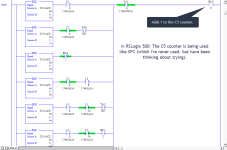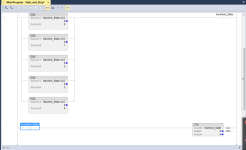AutomationTechBrian
Lifetime Supporting Member
Tonight I'm contemplating using a technique I saw the other day while troubleshooting an installation of a legacy machine for a customer of mine. Who knows, this might be common... I don't program enough to know. Thought I'd bring it up here to get a feel for what you guys think.
I saw this on a rung at the beginning of a ladder file. The machine stacks boxes. The operator enters in a set point of how high the make the stack on the pallet before the machine releases it onto the conveyor. I hooked up my laptop to the SLC 5/02 and this (pic attached) is one of the first things I saw. At first I thought it was counting the boxes and comparing it to the setpoint, but you quickly realize that doesn't make sense. The setpoint is set and compared by a Red Lion device that keeps track of the count and closes a contact when the setpoint has been met. The PLC never counts anything. As I looked at the rest of the Ladder, I saw the C5 counter being used quite a bit, at the beginning of the several different rungs. I was talking to the guy installing the machine and said, "It seems like the C5 counter keeps track of what stage the machine is in." And then it hit me... This is like the SFC programming I've been reading about in Studio 5000. But the more I looked at it's use in the Ladder, the more I like it. It's so simple! An input can mean many different things, depending on what stage the machine is in.
I was thinking about using this with an HMI momentary PB input, where you have one master control button that changes it's function depending on the stage the machine is in, or in other words, the accumulated count of the counter. My customer wanted the HMI of his machine to be simple enough that the machine could be operated by a substitute if the usual operator can't work. So I'm getting ready to re-do the ladder to utilize this counter technique.
I'm not really asking a direct question, I'm just wondering if you've used this kind of technique (a counter) to put a machine in different "stages" in Logix or Studio 5000, and if you have anything else to add about doing it this way. I've done more in 500 than in 5000, so sometimes I question old techniques in new software. My brain hasn't fully grasped using SFC yet, so I'm wondering what will be said about the comparison between the two techniques.

I saw this on a rung at the beginning of a ladder file. The machine stacks boxes. The operator enters in a set point of how high the make the stack on the pallet before the machine releases it onto the conveyor. I hooked up my laptop to the SLC 5/02 and this (pic attached) is one of the first things I saw. At first I thought it was counting the boxes and comparing it to the setpoint, but you quickly realize that doesn't make sense. The setpoint is set and compared by a Red Lion device that keeps track of the count and closes a contact when the setpoint has been met. The PLC never counts anything. As I looked at the rest of the Ladder, I saw the C5 counter being used quite a bit, at the beginning of the several different rungs. I was talking to the guy installing the machine and said, "It seems like the C5 counter keeps track of what stage the machine is in." And then it hit me... This is like the SFC programming I've been reading about in Studio 5000. But the more I looked at it's use in the Ladder, the more I like it. It's so simple! An input can mean many different things, depending on what stage the machine is in.
I was thinking about using this with an HMI momentary PB input, where you have one master control button that changes it's function depending on the stage the machine is in, or in other words, the accumulated count of the counter. My customer wanted the HMI of his machine to be simple enough that the machine could be operated by a substitute if the usual operator can't work. So I'm getting ready to re-do the ladder to utilize this counter technique.
I'm not really asking a direct question, I'm just wondering if you've used this kind of technique (a counter) to put a machine in different "stages" in Logix or Studio 5000, and if you have anything else to add about doing it this way. I've done more in 500 than in 5000, so sometimes I question old techniques in new software. My brain hasn't fully grasped using SFC yet, so I'm wondering what will be said about the comparison between the two techniques.

Last edited:




